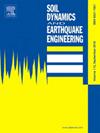Steel frame joints with multistage performance for collaboratively resisting earthquakes
IF 4.2
2区 工程技术
Q1 ENGINEERING, GEOLOGICAL
引用次数: 0
Abstract
To improve the seismic performance of buildings, the concept of multistage performance was modified based on ancient wooden buildings. The mechanical performance of a structure improved in response to increasing earthquake intensity. This represents an innovative design strategy that can be applied to both key components and overall structures. It enhances structural resilience and optimizes economic considerations. A steel frame joint with a multistage performance for collaboratively resisting earthquakes is proposed based on the modified concept. A cyclic loading test of the hinged beam–column joints was conducted to verify the finite element analysis. Subsequently, the feasibility of a joint with a multistage performance was demonstrated. When the joint rotation reached the critical point, a multistage resistance was observed. In addition, the theoretical load–displacement relationship of the joint was deduced. The load–displacement curves of the joint could be accurately predicted. A simplified analysis method for the joint is presented to reveal the joint performance of the overall structure. The hysteretic curves of the refined models were estimated accurately. From the perspective of the overall structure, the maximum and residual story drift ratios decreased owing to the joint with multistage resistance. Joints with different stories collaboratively resisted earthquakes. The modified concept was verified at both the joint and overall structural levels.
求助全文
约1分钟内获得全文
求助全文
来源期刊

Soil Dynamics and Earthquake Engineering
工程技术-地球科学综合
CiteScore
7.50
自引率
15.00%
发文量
446
审稿时长
8 months
期刊介绍:
The journal aims to encourage and enhance the role of mechanics and other disciplines as they relate to earthquake engineering by providing opportunities for the publication of the work of applied mathematicians, engineers and other applied scientists involved in solving problems closely related to the field of earthquake engineering and geotechnical earthquake engineering.
Emphasis is placed on new concepts and techniques, but case histories will also be published if they enhance the presentation and understanding of new technical concepts.
 求助内容:
求助内容: 应助结果提醒方式:
应助结果提醒方式:


